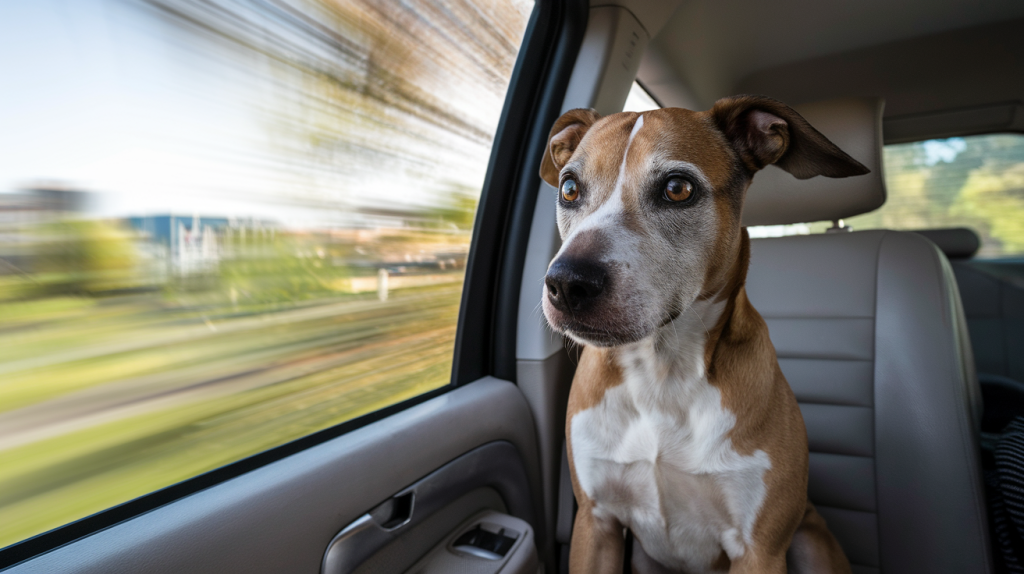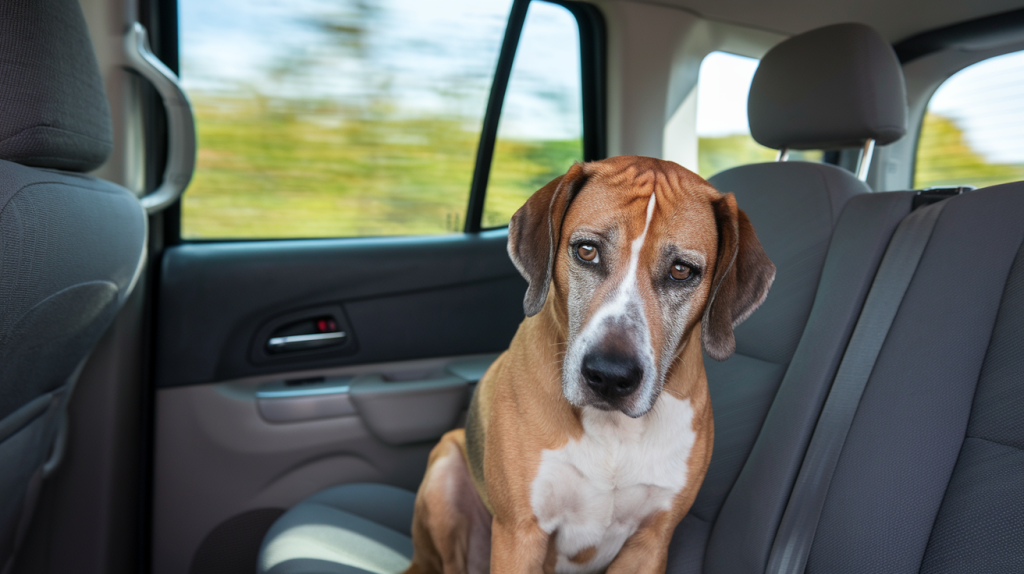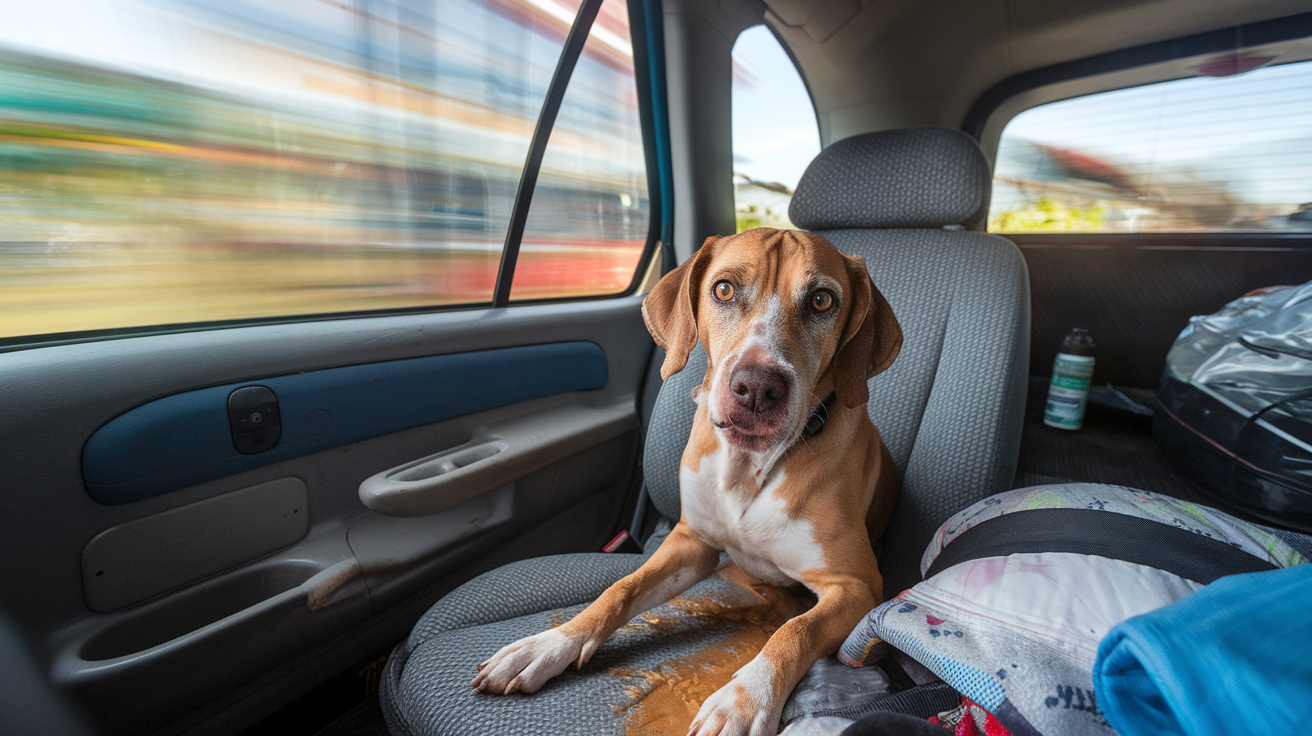Ever looked in the rearview and seen your dog feeling sick or nervous? You’re not alone. Many dog owners see their pets struggle with motion sickness. Knowing why it happens and how to help can really improve travel for your dog.
Motion sickness often hits puppies hard, just like young kids, since their inner ear isn’t fully developed. Some dogs get better as they grow, but others might feel sick on trips all their lives. Spotting the signs and learning to deal with motion sickness can turn feared trips into fun outings.
Key Takeaways
- Young puppies are more prone to motion sickness due to immature inner ear structures
- Not all dogs overcome motion sickness; it can be a lifelong issue for some
- It’s key to recognize symptoms like too much drooling, throwing up, and looking stressed
- To lessen discomfort, don’t feed your dog right before a trip
- Using products like USDA-certified organic CBD chews from Pet Releaf can relieve symptoms
- Teaching your dog to associate car rides with good things helps too
What Causes Motion Sickness in Dogs?
Motion sickness in dogs can come from different physical reasons. Mainly, it is because of how their inner ears balance them. Puppies often get motion sickness since their ear parts for balance are not fully grown. So, they might feel unsteady and anxious about car rides. Some dogs get better as they grow older. But, for others, motion sickness stays with them for life. This problem is usual in young dogs and puppies. Their inner ear parts are still developing.
Psychological causes matter a lot too. Dogs can be afraid of car rides because of bad past experiences. This fear can make them drool a lot, rest, yawn, whine, and even throw up. The fear of vomiting can make them hate car rides even more. It’s hard to tell the difference between being scared and really getting sick. But you can help them by having them face forward and making sure there is fresh air. Using fun distractions helps too.
To lessen their anxiety and avoid motion sickness, you can use counter-conditioning. Combining physical and psychological help improves your pet’s travel experience. Knowing and managing both reasons can make trips better for your pet friends.
Recognizing Symptoms of Motion Sickness in Dogs
It’s important to know the common signs of motion sickness in dogs. This way, you can help them fast. Signs to look for include whining, pacing, drooling, panting, and licking lips. You might also see swallowing, being very tired, throwing up, and having diarrhea.
During car rides, if your dog acts uneasy, like smacking lips a lot or can’t sit still, it’s a sign. When dogs don’t move much and seem sad, they might feel sick or queasy. Before a dog throws up, it may drool a lot too. You might notice your dog smacking its lips a lot or staying very still.
Sometimes, dogs that aren’t used to traveling can feel sick and throw up or have diarrhea. Catching these signs early is key to helping them feel better. Some dogs stop feeling sick when they turn one year old. Watching for these signs early is very important. Knowing these common signs of motion sickness can make trips better for you and your dog.

Preventing Motion Sickness in Dogs
To stop motion sickness in dogs, we must look at several things, like what they eat and how they get used to car rides. A key step is to not give them food for a few hours before going on a trip. This easy action helps stop them from getting sick.
Also, it’s very important to keep fresh air coming into the car. Opening a window a little bit can keep the air inside the car nice and balanced. This helps your dog not feel sick.
Using dog-specific seat belts or carriers can also make trips better for dogs. These items keep your furry friend safe and stop too much movement. Too much movement can make a dog feel sick. Young dogs and puppies often get car sick because they’re still growing. But this gets better as they get older.
Many dogs stop feeling sick in the car when they reach 12 months old. Yet, some might feel sick even when they’re adults. Slowly getting your dog used to car rides can help a lot. Begin with short drives and then go on longer ones. Doing this over time can really help stop car sickness.
It’s also key to understand that feeling scared or anxious can make car sickness worse, especially in older dogs. Using lavender scent has been shown to help calm them down. Adding these plans into your trips can make drives much nicer for your dog.
Making the Car Ride More Comfortable
When you’re going on a trip with your pet, how they see things can be very important. Dogs might feel scared or sick in the car, especially if they think of bad times like vet visits. Having your dog face forward helps stop motion sickness because backward-facing dogs can feel worse. Also, having good air in the car by opening windows a bit helps. It makes the air fresh and stops sickness.
It’s key to keep your dog safe in the car with things like seat belts or crates. These can lower their stress and keep them safe if you stop quickly. For rescue dogs, feeling safe is extra important because they might be scared of being left again. Giving them something familiar like a toy or blanket can help a lot. Keeping the air nice and the car calm also helps your pet feel better.
Planning when your dog eats can help stop motion sickness. Try not to feed them right before you leave. Doing this, plus fixing how they see things and keeping them safe, will really help their travel. Making sure they’ve played and moved around before leaving can also make them calmer.
On long rides, stopping often is a must for your dog. Taking breaks to walk and drink water helps them relax and stay comfy. This way, with good air, the right view, and safety steps, car trips are much nicer for your dog.
Conditioning and Desensitizing Your Dog
Start easing your dog’s travel anxiety by gently introducing them to a stationary car. Let your dog sniff and explore the inside without starting the engine. This calm method helps dogs get used to cars in a friendly way. Puppies might feel sick while moving but often get better as they grow.
Slowly increase how long and often you take your dog on car rides. Begin with brief jaunts close to home and make them longer over time. Your dog will need some days or weeks to like traveling by car. It’s key to make them have good feelings about car trips. Adults dogs may feel nervous on rides if they weren’t used to it young.
Using treats and toys as rewards can make training fun. This approach shows that car rides can be enjoyable. It’s important to keep your pet calm during this time. Gradual exposure and a soothing setting can help with signs of motion sickness.
Tools like Adaptil®, a calming spray, can ease travel worries. Always secure your dog well in a crate or car harness for safety. If your dog seems really upset, you might need to talk to a vet for medication.
Natural Remedies for Dog Motion Sickness
Natural remedies for dog motion sickness are a gentle alternative to pills. Around 10 to 15% of dogs in the U.S. get car sick. This is more common in younger dogs whose bodies are still growing. Herbal solutions like ginger and lavender can really help these dogs feel better.
Ginger is well known for stopping nausea. It works as well as some medicines but is safer. Lavender oil makes dogs calm and less sick. CBD oil from hemp plants is good for nausea and anxiety in dogs.
Each herbal remedy has a specific amount you should use based on your dog’s size. Homeopathic treatments like Nux Vomica and others are also available. They come with clear instructions.
Behavioral methods also help along with herbs. Items that smell like home and toys that soothe can comfort your dog. Dog calming pheromones, sprayed in the car, can relax your dog.
Crates restrict your dog’s view out the window, reducing sickness. Opening windows can either help or hurt, depending on your dog. Watching your dog’s behavior is key. Signs like chewing or panting mean stress might be the cause.
Treatment for Motion Sickness in Dogs
If your dog gets sick while moving, there are ways to help. Always talk to a vet first. They know the best steps to take. There are meds you can buy without a prescription and ones your vet prescribes.
Maropitant citrate (Cerenia) is a great FDA-approved drug for stopping nausea in dogs. It works for up to 24 hours. Bonine (meclizine) is another choice. Give it one to two hours before going somewhere. It also lasts for a whole day. Dramamine is a quick option too. It starts working 30 minutes before you leave and keeps working for three to six hours.
Some common meds you can buy yourself are antihistamines. They help your dog feel less nauseous and calm. They can also lessen drooling. But, they might make your dog sleepy or cause diarrhea.
For dogs that get very stressed or anxious, special meds might be needed. Drugs like trazodone, acepromazine, and alprazolam can help. Phenobarbital and diazepam are also options. They make dogs less anxious before trips.
Sometimes, natural remedies and changes in behavior aren’t enough. That’s when drugs can really help. But remember to check with your vet first. They will help you pick the safest and most effective treatment for your dog.
Understanding the Role of Stress and Anxiety
Stress and anxiety can make your dog’s car sickness worse. This can be due to bad past car rides, how they are born, and their ears not being fully developed. Knowing these facts helps keep your dog happy and makes trips better for them.
To manage your dog’s travel anxiety, we can do several things. Slowly getting them used to car rides and making trips fun is important. Also, taking short breaks on long rides and keeping the car calm helps a lot.
Using things like window shades or a Thundercap can also ease anxiety and sickness. Such tools are great for your dog’s mood.
Medicines and natural things can help with anxiety and motion sickness too. Things like Adaptil® are good for calming dogs. Using ginger and nice smells like lavender can also reduce stress during trips.
Talking to a vet to find the best way to help your dog is important. Whether it’s medicine or other methods, it makes trips nicer for both of you.

Frequently Asked Questions about Motion Sickness in Dogs
It’s important to know how to help your dog feel better during car rides. We’ve gathered common questions about motion sickness in dogs. Here, you’ll find useful tips and advice.
What causes motion sickness in dogs? Many dogs, especially young ones, get car sick. Their inner ear isn’t fully developed. Feeling anxious or not used to car rides can make things worse.
How can I tell if my dog is experiencing motion sickness? Look for signs like panting, drooling, and being sick. Dogs might also shake, cry, or be unable to settle down. Watching your dog can help you notice these signs quickly.
What treatments are available for motion sickness in dogs? There are a few options. Medicine like Cerenia can stop sickness, working well for most dogs. Some over-the-counter medicines can help too, but they might make your dog sleepy. Ginger and other natural remedies have helped some dogs, but we don’t know a lot about them yet.
Can motion sickness be prevented? Yes, getting your dog used to car rides can reduce sickness. Make the car a happy place with toys and treats. Using a crate or harness, and bringing things that smell like home help too. Also, letting your dog look forward and providing fresh air can keep them from feeling sick.
With this info, we want to help you and your dog enjoy trips without worry. Using these tips can make car rides smoother for your pet and you.


